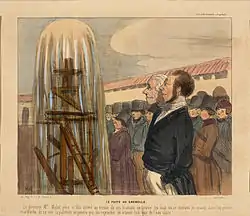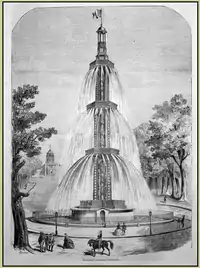Louis-Georges Mulot
Louis-Georges Mulot (14 September 1792, Épinay-sur-Seine - 11 April 1872, Paris) was a French engineer and entrepreneur. He helped create numerous artesian wells in Paris and was the founder of the Compagnie des mines de Dourges; one of the first extensions of the Nord-Pas de Calais Mining Basin.

Biography
His father was a locksmith; originally from Vaubexy. After inheriting his father's tools, he proved to be very skillful with his hands; mending shotguns and clocks as well as locks. He also invented a device to improve the process of grating potatoes into potato starch and repaired a steamboat that had been stranded on the Seine.[1]

In 1823, he was called to Enghien-les-Bains to repair the tools of workers who were digging an artesian well. He watched them at work and learned the process. Upon returning home, he created his own tools and dug his first well on the property of the Marquise de Grollier, an artist who specialized in flower painting.[2] He then dug similar wells in Tours, Elbeuf and Saint-Gratien.[3]
In 1834, at the suggestion of François Arago, a noted scientist who was serving as the Conseil Général of the Seine, and Louis-Étienne Héricart de Thury, an engineer, he undertook his first well drilling project in Paris, in the courtyard of the Abattoirs de Grenelle. After seven years, drilling to 548 meters (1,798 feet), he struck water.[4] He went on to create more wells throughout France and Algeria. The one at Grenelle went dry only recently.
While searching for drilling locations in Dourges and Hénin-Beaumont, he discovered the first indication that coal fields existed beyond Douai. This was initially kept secret.[5] At the end of 1848, he and other interested parties applied for a concession. Rival claims from the Compagnie des mines de l'Escarpelle and the Compagnie des mines de Courrières delayed the process.
A decree in August of 1852 established a concession of 3,787 hectares (app. 9,358 acres) in the environs of Dourges, followed shortly by the creation of the Compagnie des mines de Dourges.

Capitalizing on this success, he began engineering large structures, with a cement drilling and pouring technique of his won devising. He also participated in the construction of some railways. He was named Knight in the Legion of Honor by King Louis-Philippe I and obtained a lifetime annuity of 3,000 Francs.
References
- Magazine municipal de la ville d'Épinay-sur-Seine, April 2009, #85.
- From the Journal d'agriculture, lettres et arts du département de l'Ain, a report by Louis-Étienne Héricart de Thury to the Académie d'Agriculture, 15 April 1828, P. F. Bottier, editor Online
- Bulletin municipal de Saint-Gratien (Saint-Gratien en VO), December 2008, #3
- Notice sur le puits artésien de Grenelle, from the Revue des deux Mondes 1842. Online @ Wikisource
- Le Bassin Houiller du Pas-de-Calais. Vol. I "Histoire de la recherche, de la découverte et de l'exploitation de la houille dans ce nouveau basin", by Émile Vuillemin, Imprimerie L. Danel, Lille, 1880 Online
Further reading
- Pierre Hyacinthe Azaïs, Explication et histoire du puits de Grenelle, 1854
- Charles Peligot Laboulaye, Bulletin de la société d'encouragement pour l'industrie nationale, Obituary of Louis-Georges Mulot, 1873
- Guy Dubois, Jean-Marie Minot, Histoire des Mines du Nord et du Pas-de-Calais, Des origines à 1939-45, 1991
External links
| Wikimedia Commons has media related to Louis-Georges Mulot. |